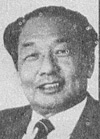| Shenzhen, China's first and largest special economic zone, began experimental operation in 1980. As an open window to foreign investment, the zone's development has always received the attention of foreign businessmen and world economists.
Liang Xiang, secretary of the Shenzhen municipal committee of the Chinese Communist Party, gives a brief account of the zone's evolution in the past five years and may help to widen the readers' perspective on China's economic zones.

The Shenzhen Special Economic Zone, one of China's "testing grounds" for opening windows to the world economy, was established in August 1980 with the approval of the Standing Committee of the National People's Congress.
In the initial stage after its establishment, because of the influence of the models of foreign "export products processing zone" and "free trade zone," Shenzhen's economic links with enterprises in the hinterland were neglected. The special zone's system also followed the economic pattern of the hinterland.
Acting upon a directive of the Party Central Committee after 1981, the local authorities have conducted reforms of the special zone's economic structure and have adopted special policies, thus speeding up the development of the special zone.
Achievements and problems
With regard to the operation of special economic zones in socialist China, there is no precedent to go by. We have begun by laying the groundwork in Shenzhen over the past five years or so.
- Investment environment. Originally a desolate, small border town in China's Guangdong Province, Shenzhen's infrastructure facilities, especially its energy, telecommunications and transportation industries, were very backward. So in the past few years, the local authorities have concentrated their human, financial and material resources on the construction of the Luohu and Shangbu urban districts covering an area of 36 square kilometres; building and expanding more than 80 urban roads of 100 kilometres; and setting up the Shekou, Shangbu and Bagualing industrial districts that have begun to take shape. In addition, the construction of four other industrial districts is in full swing.
A batch of cultural, tourist and commercial service facilities, municipal projects and workers' dorms have also been put up. At the same time, energy supply, transportation and telecommunication services have improved. One of these improvements was the 700,000-kw Shajao thermal power plant built with the aid of foreign capital, its first 350,000-kw generating unit will begin operation next year.
Among other projects are a helicopter airport; the construction of four harbours; a water and land transportation network; and a 11,000-channel programme-controlled telephone exchange system recently put into service, making it possible to directly dial Hongkong and a dozen cities in China's hinterland.
Through several years of hard work, Shenzhen has begun to create a favourable investment environment to attract foreign capital.
Capital construction conducted over the past few years has involved a cumulative investment of about 6 billion yuan and projects that have been completed cover an area of about 8.08 million square metres of floor space.
The sources of funds were as follows: Foreign capital accounts for about 20 percent; funds raised by Shenzhen itself make up 27 percent; investment in Shenzhen enterprises made by central ministries and the nation's provinces and cities constitutes 12 percent; bank loans represent 30 percent; state investment comprises about 3 percent; and others (including nuclear power stations) take up about 8 percent.
In addition, Shenzhen authorities have enacted about a dozen economic laws and regulations and a number of others have been submitted to the higher authorities for examination and approval.
- Importing foreign funds and advanced technology. Business people from 17 countries and regions have come to Shenzhen to check into the possibilities of investing in enterprises. By October 1985, more than 4,300 agreements on construction projects had been signed with foreign businessmen, involving a total investment of $3.1 billion, $840 million of which had been put to use, accounting for one-seventh of the nation's gross direct foreign investment.
The city imported more than 30,000 pieces of equipment, about 40 percent of which were comparatively advanced. These included plastic-spraying machines, electronic component automatic inserting machines, hollow glass production line, plastic-woven bag production line, precision mould processing equipment, microcomputer production equipment, large injection plastic equipment, hard plastic processing equipment and satellite television ground receiving equipment. These technology and equipment are up to advanced international levels and some of them have filled in China's gaps in these fields.
With the introduction of foreign funds and technology, a number of foreign-owned enterprises, Chinese-foreign joint ventures and co-operative enterprises have been set up in the special economic zone. More than 85 percent of these businesses have turned out profits, and more than 400 varieties of their products have entered the international market.
The Shenzhen authorities have also carried out economic cooperation with the other departments and enterprises in the hinterland in order to solve the zone's shortage of funds, talent and resources. The city currently has established links with 969 enterprises throughout China, including 338 enterprises operating under 25 ministries of the State Council, 395 enterprises under 27 of the nation's provinces, municipalities and autonomous regions and 236 enterprises under other areas and cities. These enterprises have generally brought in good economic results, earning a total of around 500 million yuan in 1984.
- Comprehensive economic growth. Compared with 1979, the zone's industrial enterprises have increased in number from 224 to the current 750; the number of workers and staff members has increased from more than 8,700 people to more than 60,000 people; and total industrial output value rose from 60 million yuan to 1.8 billion yuan in 1984 - 30 times greater than that of 1979. Total industrial output value in 1985 was estimated at 2.4 billion yuan, an increase of 33 percent over 1984.
The structure of industry in Shenzhen has undergone remarkable changes in the last several years. Formerly, the zone mainly processed materials from outside sources, but now it produces most of its own products, totalling more than 800 varieties.
| 